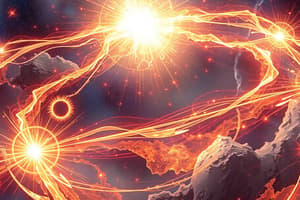Podcast
Questions and Answers
Which fundamental force is responsible for the stability of atomic nuclei?
Which fundamental force is responsible for the stability of atomic nuclei?
- Weak Nuclear Force
- Strong Nuclear Force (correct)
- Electromagnetism
- Gravity
According to Newton's Second Law, what happens to acceleration if the mass of an object is increased while the net force remains constant?
According to Newton's Second Law, what happens to acceleration if the mass of an object is increased while the net force remains constant?
- Acceleration becomes negative
- Acceleration remains the same
- Acceleration increases
- Acceleration decreases (correct)
What is the implication of the Second Law of Thermodynamics in a closed system?
What is the implication of the Second Law of Thermodynamics in a closed system?
- Entropy will decrease over time
- Energy can be created without limits
- Energy remains constant indefinitely
- Entropy will eventually increase (correct)
Which type of wave is characterized by particle displacement being parallel to wave propagation?
Which type of wave is characterized by particle displacement being parallel to wave propagation?
In electrical circuits, how does the total resistance in a series configuration compare to individual resistances?
In electrical circuits, how does the total resistance in a series configuration compare to individual resistances?
What characterizes the behavior of particles according to quantum mechanics?
What characterizes the behavior of particles according to quantum mechanics?
Which variable does Ohm's Law express as directly proportional to voltage?
Which variable does Ohm's Law express as directly proportional to voltage?
In physics, what does the equation $W = Fd , cos(\theta)$ calculate?
In physics, what does the equation $W = Fd , cos(\theta)$ calculate?
Flashcards are hidden until you start studying
Study Notes
Key Concepts in Physics
-
Fundamental Forces
- Gravity: Attraction between masses.
- Electromagnetism: Interaction between charged particles.
- Strong Nuclear Force: Holds protons and neutrons in the nucleus.
- Weak Nuclear Force: Responsible for radioactive decay.
-
Laws of Motion (Newton's Laws)
- First Law (Inertia): An object at rest stays at rest, and an object in motion stays in motion unless acted upon by a net external force.
- Second Law (F=ma): The acceleration of an object is directly proportional to the net force acting upon it and inversely proportional to its mass.
- Third Law (Action-Reaction): For every action, there is an equal and opposite reaction.
-
Energy Forms and Conservation
- Kinetic Energy: Energy of motion (KE = 1/2 mv²).
- Potential Energy: Stored energy based on position (PE = mgh).
- Conservation of Energy: Energy cannot be created or destroyed, only transformed.
-
Thermodynamics
- First Law: Energy conservation in thermodynamic processes.
- Second Law: Entropy of an isolated system always increases.
- Third Law: Absolute zero is unattainable.
-
Waves and Oscillations
- Wave Properties: Amplitude, wavelength, frequency, speed.
- Types of Waves: Transverse (e.g., light) and Longitudinal (e.g., sound).
- Superposition Principle: Overlapping waves combine to form a resultant wave.
-
Electricity and Magnetism
- Ohm's Law: Voltage = Current × Resistance (V = IR).
- Circuits: Series and parallel configurations affect total resistance and current flow.
- Magnetic Fields: Created by moving charges; influence the motion of other charges.
-
Modern Physics
- Quantum Mechanics: Behavior of particles at the atomic and subatomic levels.
- Relativity: Einstein’s theories of special and general relativity; time dilation, mass-energy equivalence (E=mc²).
-
Key Equations
- Motion: ( s = ut + \frac{1}{2} a t^2 )
- Work: ( W = Fd \cos(\theta) )
- Power: ( P = \frac{W}{t} )
- Momentum: ( p = mv )
-
Applications of Physics
- Engineering: Structural analysis, mechanical systems.
- Electronics: Circuit design, semiconductor physics.
- Astronomy: Orbital mechanics, cosmology.
Study Tips
- Understand concepts through real-life applications.
- Solve practice problems to reinforce mathematical formulations.
- Use visual aids like diagrams and charts to grasp complex ideas.
- Review key terms and definitions regularly to build vocabulary.
Fundamental Forces
- Gravity: Universal attraction between masses, governs planetary motion.
- Electromagnetism: Interaction between charged particles, responsible for electric and magnetic phenomena.
- Strong Nuclear Force: Binds protons and neutrons together in atomic nuclei, overcoming electromagnetic repulsion.
- Weak Nuclear Force: Governs processes like beta decay, essential in nuclear reactions.
Laws of Motion (Newton's Laws)
- First Law (Inertia): Objects resist changes to their state of motion unless influenced by external forces.
- Second Law (F=ma): The relationship between force, mass, and acceleration; greater mass requires more force to accelerate.
- Third Law (Action-Reaction): Actions result in equal and opposite reactions, emphasizing the interplay of forces.
Energy Forms and Conservation
- Kinetic Energy (KE): Energy due to an object's motion; calculated as ( KE = \frac{1}{2} mv^2 ).
- Potential Energy (PE): Energy stored based on an object's position; calculated as ( PE = mgh ).
- Conservation of Energy: Principle stating energy exists in various forms but is neither created nor destroyed, only transformed.
Thermodynamics
- First Law: Acknowledges the conservation of energy within thermodynamic processes.
- Second Law: States that entropy, or disorder, in an isolated system tends to increase over time.
- Third Law: As temperature approaches absolute zero, the entropy of a system approaches a constant minimum.
Waves and Oscillations
- Wave Properties: Key characteristics include amplitude (height), wavelength (distance between peaks), frequency (cycles per second), and speed (wave travel rate).
- Types of Waves: Transverse waves (e.g., light) move perpendicular to disturbance; longitudinal waves (e.g., sound) move parallel.
- Superposition Principle: When waves overlap, they combine to form a resultant wave, illustrating interference patterns.
Electricity and Magnetism
- Ohm's Law: Establishes the relationship between voltage, current, and resistance, expressed as ( V = IR ).
- Circuits: Analyze series and parallel circuits to understand resistance effects and current flow variations.
- Magnetic Fields: Generated by moving charges, they affect the motion of other charged particles, playing a key role in electromagnetic applications.
Modern Physics
- Quantum Mechanics: Describes the behavior of subatomic particles, introducing concepts like wave-particle duality.
- Relativity: Einstein’s theories explain the physics of moving bodies; key concepts include time dilation and mass-energy equivalence (expressed as ( E=mc^2 )).
Key Equations
- Motion: ( s = ut + \frac{1}{2} a t^2 ), describing displacement in terms of initial velocity, time, and acceleration.
- Work: ( W = Fd \cos(\theta) ), calculating work done based on force applied and displacement in the direction of the force.
- Power: ( P = \frac{W}{t} ), defining power as work done over time.
- Momentum: ( p = mv ), indicating the product of mass and velocity, showcasing an object’s motion quantity.
Applications of Physics
- Engineering: Utilized for structural analysis and the design of mechanical systems to ensure safety and functionality.
- Electronics: Involves circuit design principles and semiconductor physics for developing modern electronic devices.
- Astronomy: Employs principles of mechanics to study celestial bodies and the fundamental laws governing the universe.
Study Tips
- Connect theoretical concepts to real-world scenarios for better understanding.
- Practice solving problems to reinforce your grasp of formulas and principles.
- Utilize diagrams and charts to visualize and comprehend complex topics.
- Regularly review vocabulary to strengthen understanding of key terms and definitions.
Studying That Suits You
Use AI to generate personalized quizzes and flashcards to suit your learning preferences.




